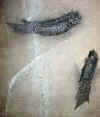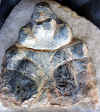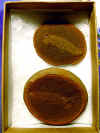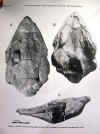SARCOPTERYGII Actinistia and Dipnomorpha
This group is characterised by the articulation of the paired fins, with the fin musculature extending into the basal lobe and the entire tooth being covered with enamel. Their fossil record starts in the early Devonian although the more primitive taxa seem to appear later indicating the stratigraphical distribution does not match closely the current accepted pattern of their interrelationships and hence much of their development must have occurred much earlier than the fossil record would suggest.
The Sarcopterygians are divided into 7 groups
Onychodontiformes, Actinistia (including the extant coelacanth, Latimeria), Dipnomorpha (including the Dipnoi, lungfishes), Rhizodontiformes, Osteolepiformes, Panderichthydia and the Tetrapoda.
Actinistia
The fossil record begins in the Giventian, with the number of species increasing from the Devonian to Carboniferous, they decrease in the Permian, peak in the Triassic, decrease to the end of the Cretaceous, then disappear from the fossil record from the Tertiary. The early Coelacanths such as Miguashaia show remarkable similarities to the extant form, Latimera.
Actinista in my collection (click on thumbnails to see larger images)
Caridosuctor populosum Mississippian Bear Gulch, USA
Chinlea Sorenseni Triassic Colorado USA
Exact spec. described Elliott, D.K 1987. A new specimen of Chinlea Sorenseni from the Chinle Formation, Delores River, Colorado. Journal of the Arizona-Nevada Academy of Science 22:47-52
![]()
![]() Whiteia
woodwardi
Permian,
Madagascar
Whiteia
woodwardi
Permian,
Madagascar


 Rhabdoderma sp.
Upper Carboniferous Mazon creek, USA
Rhabdoderma sp.
Upper Carboniferous Mazon creek, USA
Dipnomorpha
The Porolepiformes and Dipnoi are the two major taxa.
The Porolepiformes or holoptychids as they are also known are exclusively Devonian fish with stout bodies, a blunt snout, an epiceral tail, long leaf-shaped pectoral fins and strongly folded teeth (shared with the osteolepiformes)
![]()
 Glyptolepis
paucidens Mid Devonian
Achanarras,
Scotland
Glyptolepis
paucidens Mid Devonian
Achanarras,
Scotland
The Dipnoi are best characterised by large toothplates that derive from modifications of the entopterygoids and prearticular. Other than having more heavily ossified sketetons and being much more diverse, the Devonian Lungfish are very similar to extant examples. Given their presumed relationship to the Tetrapods, this taxa is always subject to much debate.
Dipnoi in my collection (click on thumbnails to see larger images)
Dipterus vallenciennesi

 Mid Devonian Achanarras,
Scotland very
large (O.macrolepidotus for scale)
Mid Devonian Achanarras,
Scotland very
large (O.macrolepidotus for scale)

 Mid Devonian Achanarras,
Scotland
note good pectoral
fins
Mid Devonian Achanarras,
Scotland
note good pectoral
fins
 Mid Devonian Caithness,
Scotland
Osteolepis
association plate
Mid Devonian Caithness,
Scotland
Osteolepis
association plate

 Pentlandia macroptera Mid
Devonian Caithness,
Scotland
Pentlandia macroptera Mid
Devonian Caithness,
Scotland
 Sagenodus obligatus (upper jaw and
tooth), Newsham,UK
Sagenodus obligatus (upper jaw and
tooth), Newsham,UK
Scaumenacia curata Upper Devonian Escuminac Formation, Miguasha, Quebec, Canada
 Dipnotuberculus gnathodus
Mid Devonian Mader, Morocco
Dipnotuberculus gnathodus
Mid Devonian Mader, Morocco
 Esconichthys apopyris
Upper Carboniferous Mazon creek USA
Esconichthys apopyris
Upper Carboniferous Mazon creek USA
SARCOPTERYGII Images from 'Dura Den - A monograph of the Yellow sandstone' 1859 J Anderson
















